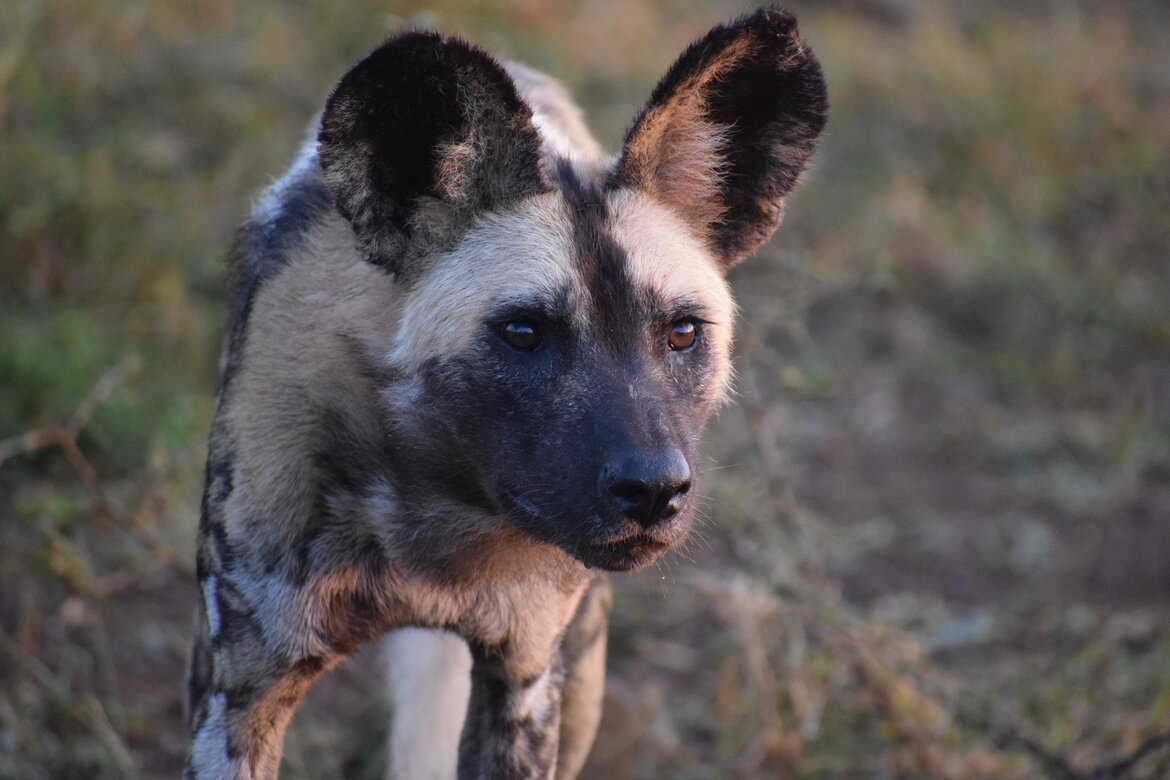“African Wild Dogs are one of the iconic predators in the African ecosystem. Conserving African Wild Dogs is important, not only for the essential ecosystem services they perform, but also for their unique aesthetic beauty as well as the incredible family bonds and intelligence they portray as they energetically move or hunt through the landscape.” – Mike Staegemann, Wildlife ACT Wild Dog Programme Manager.
About African Wild Dogs
African Wild Dog were once found throughout most of Sub-Saharan Africa. Today, a mere 6,600 individuals are found on the continent, and they have become Southern Africa’s most endangered carnivore.
Although having a dog-like appearance, the name African Wild Dog is very misleading as they are evolutionarily distinct from the Canis genus which contains both wolves and dogs. They are in fact the last remaining member of their genus – Lycaon (Greek meaning wolf-like) – and are listed as Endangered under the IUCN Red list.
Why conserving African Wild Dogs is so important
African Wild Dogs play an integral role in the African ecosystem. Their highly co-operative hunting behaviour coupled with high stamina has made them the most successful mammalian predator in Africa with a hunting success rate of around 75%.
This high success rate helps in maintaining a healthy ecosystem through the removal of sick and weak individuals. Although favouring medium sized antelope, Wild Dogs are generalist hunters and have a wide range of prey. This ability to hunt and move a wide prey selection around an ecosystem not only helps to ensure that prey numbers are maintained, but also regulates the vegetation of the area.
The history of African Wild Dog Conservation in South Africa
During the early 1990’s, the only viable Wild Dog population within South Africa was located in the Kruger National Park. In 1997, a national workshop was held to assess the Wild Dog population and habitat viability in South Africa. One issue identified was the need to establish a second viable population within South Africa. However, Wild Dogs require very large areas and the unavailability of such large wild-free space within South Africa proved an initial challenge.
To overcome this, the decision was taken to create a Wild Dog metapopulation management system within South Africa to increase the population size and distribution range of Wild Dogs throughout the country. A network of protected areas outside of Kruger National Park was identified and targeted to establish nine Wild Dog packs within a ten year period.
Following this metapopulation theory, a system of transferring and relocating individuals between reserves was set up to mimic natural dispersal and colonisation events. A specialist Wild Dog Advisory Group of South Africa (WAG-SA) comprising scientists, ecologists, conservationists, researchers, reserve managers and private landowners was formed.
WAG-SA was tasked to monitor, implement and advise on the management of Wild Dogs in South Africa, according to a strict criterion-based framework.
The history of African Wild Dog Conservation in KZN
Historically, Wild Dogs were considered widespread throughout KwaZulu-Natal (KZN), however, the last recorded pack had disappeared from the Zululand region in the 1930’s. In an attempt to recolonise the area, Wild Dogs were reintroduced into the Hluhluwe-iMfolozi Park (HiP) in the early 1980’s. This population was incorporated within the South African Metapopulation management strategy developed by WAG-SA, and their management approach has also been adopted for conserving African Wild Dogs in KZN.
This led to the formation of the Zululand Wild Dog Management Forum in 2004 (today known as the KZN Wild Dog Management Group – KZN WDMG) to provide guidance on the conservation management of the KZN Wild Dog population and to contribute to the national metapopulation strategy.
Key threats to the African Wild Dog populations are loss of and fragmented habitats with little or no connectivity between them. Direct persecution and misconceptions around the species by communities and farmers. Diseases such as rabies, canine distemper and TB as they encounter domestic animals (dogs in particular), and poaching, mainly through targeted and accidental snaring.
How Wildlife ACT contributes to African Wild Dog Conservation
Wildlife ACT has always had a strong presence in WAG-SA, with Conservation Director Chris Kelly attending since our establishment in 2008, and currently sitting on the committee and heading up the Management Group.
On the ground, Wildlife ACT works tirelessly to provide high-quality daily monitoring of African Wild Dogs across KwaZulu-Natal, as well as emergency response, capture and relocation assistance and community education and awareness. This is part of an integral approach to conserving African Wild Dogs.
Wildlife ACT is unique in that we actively advance conservation by initiating, implementing and managing monitoring projects on reserves which do not have existing monitoring programmes in place; or by taking over existing monitoring projects on reserves that can no longer fund or manage them.
Wildlife Monitoring & Tracking
Wildlife ACT and its partners also drive funding to ensure modern tracking technology can be used to assist in locating individuals and packs. Wildlife ACT assists in the fitting of these devices and has been integral in providing over 335 collars to African Wild Dogs since 2010.
Additionally, Wildlife ACT works closely with partners such as Ezemvelo KZN Wildlife (EKZNW) and the Endangered Wildlife Trust (EWT) and is a key member of both the WAG-SA and the KZN WDMG.
Wildlife ACT, along with our partners, make available the relevant data collected through our monitoring efforts to be used for research projects to increase our understanding and knowledge of African Wild Dogs and inform the existing adaptive management approach.
Find out more about Wildlife ACT’s work with conserving African Wild Dogs and how you can get involved by joining our Endangered Species Monitoring programme.
